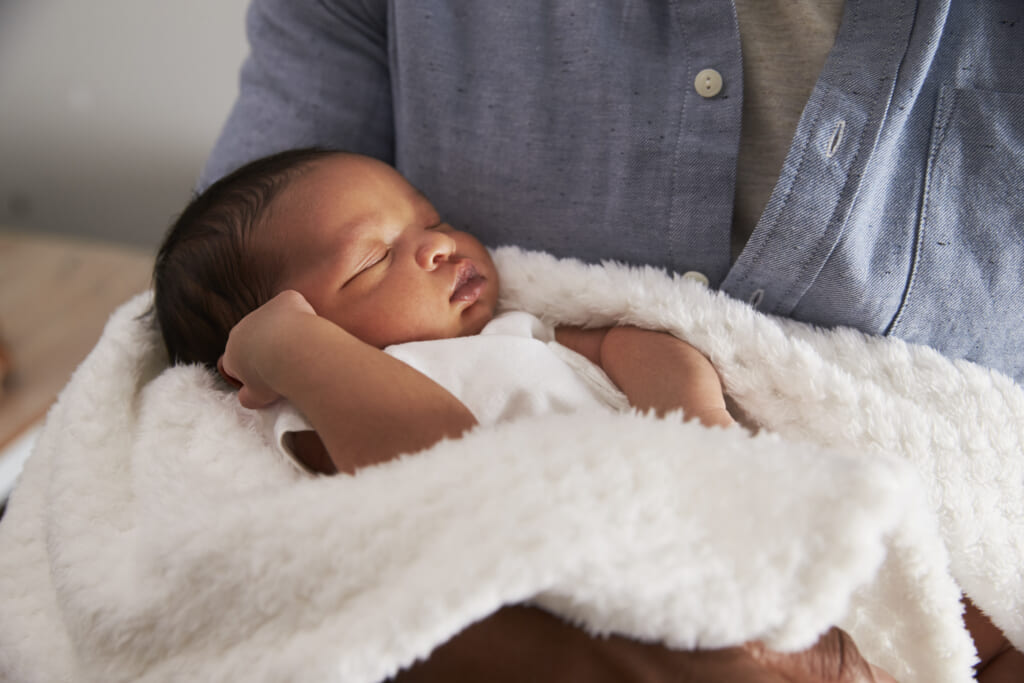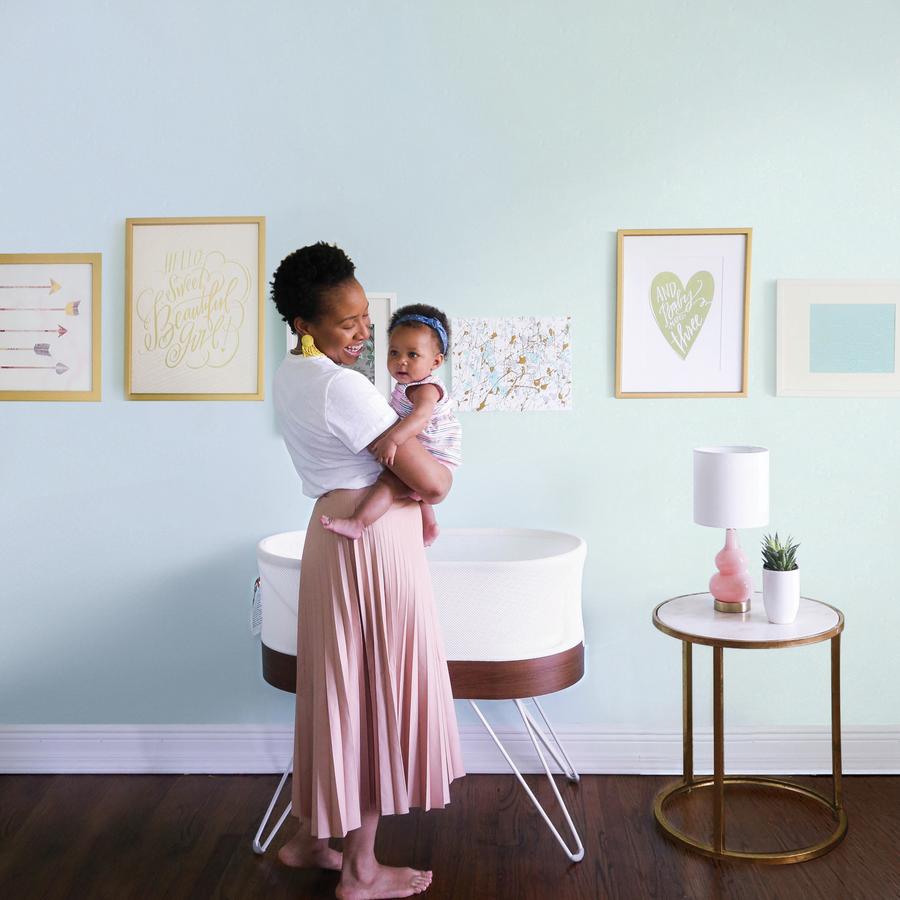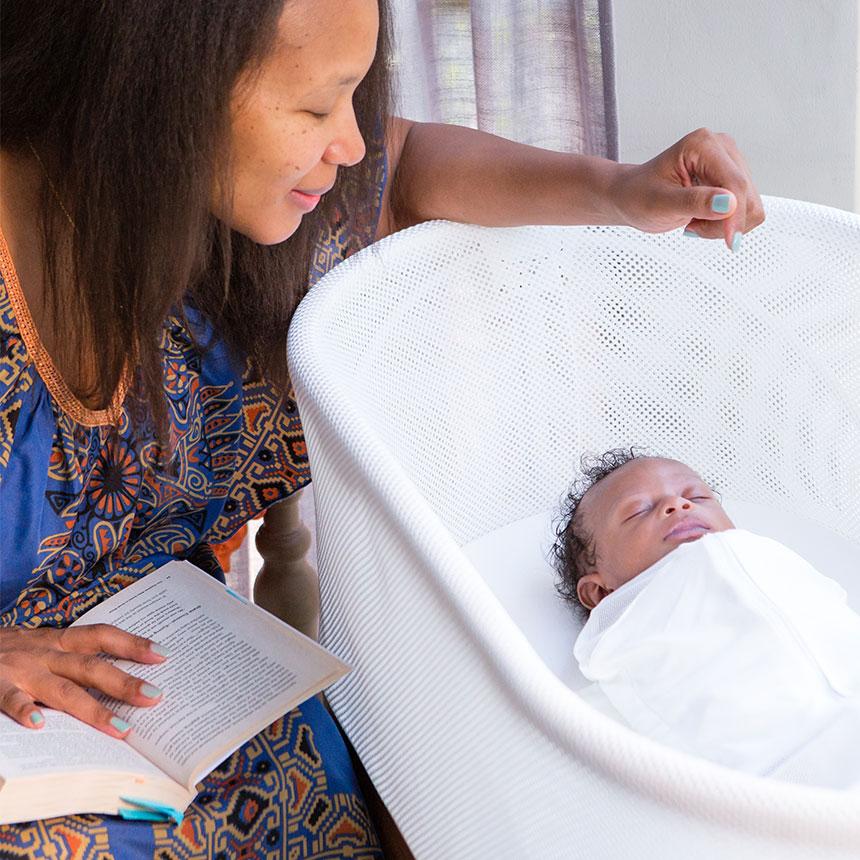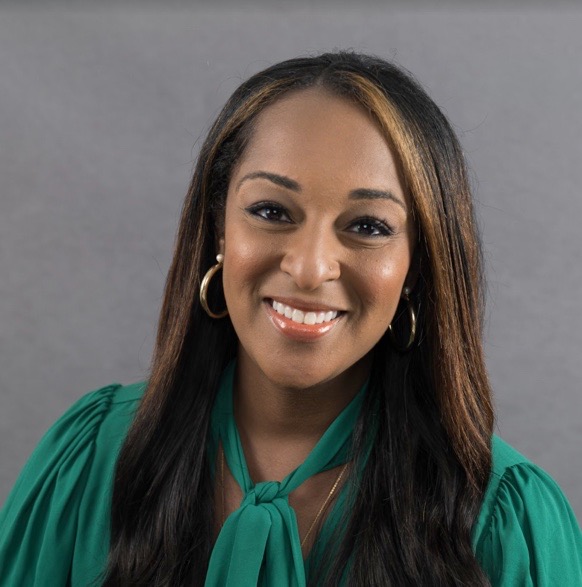It was around 6 a.m. one morning when I realized I’d be watching the sunrise trying to get my newborn to sleep. Like most new moms, I loved gazing at my baby son’s tiny face in awe. I also usually loved the sunrise. It was hopeful. It was pretty. And it signaled that I was up and ahead for the day. But on this day, seeing orange fade into the sky made me feel more depressed than ever.
I couldn’t tell you what day it was (were they really all that different anyway?), or how many times the baby had woken up at that point, but I did know that if I didn’t get more sleep during my first months as a parent, I was going to have a breakdown. Having a baby is hard, period. But having one in a pandemic meant fewer hands of support physically present unless you paid for help long-term.

I never understood it before, but I finally could see how parents could fall asleep with their baby in hand or on the bed — a dangerous situation that can lead to SIDS (sudden infant death syndrome), a tragic syndrome that disproportionately impacts Black babies.
My story isn’t unique. Survey after survey delivers the not so surprising news that parents lose a lot of sleep the first year of a baby’s life (133 nights to be exact, according to one survey—that’s more than ⅓ of a year’s worth of shut-eye). Everyone has their tried and true tips for getting more, including the good ol’ “sleep when the baby sleeps,” which would work perfectly if newborn babies didn’t have a schedule like tiny Draculas.
But the newest cult favorite sleep solution has come in the form of an award-winning smart bassinet, called the SNOO. The SNOO swaddles babies in a secured sleep-sack, and the bed responds to their cries by mimicking the womb with automatic rocking and white noise, which for the right sweet tiny humans, will soothe them back to sleep. It sounds simple, but this allows their desperately tired parents and caregivers to get an extra precious stretch of uninterrupted sleep.

The SNOO’s purpose has even expanded beyond the traditional baby market and it’s being used in more than 100 hospitals across the U.S. to help comfort babies in nurseries that are low on staff. While the SNOO’s $1,500 price tag has made it a luxury for some, it’s now available to rent for $30 a month, and could soon be covered by insurance companies pending FDA approval.
It has already been declared a breakthrough device by the FDA for its ability to reduce SIDS, which disproportionately impacts Black babies, and has had no reported injuries or deaths from usage. While it may be a tradition in some homes to co-sleep with babies or put them on their stomachs, NIH.gov says the “single most effective action” to reduce a baby’s risk of SIDS is putting the baby on their back to sleep.
“You feel like the baby is safer being with you but actually, the baby is at higher risk because they can roll into a pillow or they can get face down,” says Dr. Harvey Karp, pediatrician, child development expert, and founder of the SNOO. “Half of the babies who die are in bed with their parents. You will never recover from that experience if you wake up and you find your baby next to you not breathing.”
Dr. Karp says it’s not just SIDS that disproportionately affects Black families, but also issues like maternal mortality and postpartum depression.
“A big part of postpartum depression is crying babies, exhaustion, fear in the middle of the night that your baby’s going to roll to an unsafe position and feeling like you’ve got nobody to help you,” says Dr. Karp.
Long before the SNOO existed, SNOO’s founder Dr. Karp was establishing a community of faithful readers around the best practices for getting babies to sleep through his book, The Happiest Baby On the Block, and 5 S’s program. TheGrio talked with Dr. Karp about various tips for parents and larger thoughts about supporting Black communities in the fight against SIDS.
October is SIDS Awareness Month, which means that if just one baby’s life is saved from conversations about safer sleeping, it’s worth it. Here are some highlights.
TheGrio: What do I do when my baby sleeps all day, but won’t sleep at night?
Dr. Karp: The more he sleeps during the day, the more he’s going to be awake at night. And we can flip that. If we try to give him a little bit more food during the day, that doesn’t mean he’s going to take it. In other words, sometimes you wake him up after two hours and you don’t want to wake up. You know, he just is like, you know, jelly in your hands.
So then you put him back down for another half hour. Forty-five minutes [later] and you try it again. Most of the time, kids will, after an hour and a half or two hours at the most, wake up and take the feeding. Then you might just go right back to sleep and just put him down again. That way you’re kind of getting the calories in during the daytime. So he’s naturally going to need less of that at nighttime.
TG: Is there such a thing as holding your newborn baby too much? Does it spoil them?
Dr. Karp: There is not too much. [Your baby] was inside of you being carried, held, and jiggled 24/7. If you hold him 12 hours a day, which I know you’re not doing, but if you did hold them 12 hours a day, he’d look and go, “It’s 50 percent rip off” from where he used to be.
The idea that babies get spoiled or used to it is an appropriate idea when kids get to be 9 months old, 12 months old, and you don’t just want to give in every time he screams. Since he was kicked out of the womb, his happy home, the least you can do is go to meet his needs when he has it. Pretty much [those] needs are just: change the diaper, feed me or hold me. Right? That’s your job at this point in time.

The benefit of doing that is not that you’re going to spoil him and make him become difficult to be around. Quite the opposite. What you’re teaching him is to trust you guys to feel secure. Ultimately, it’s something they call attachment.
As we go through life and we have relationships, friendships, and things like that. We have to be secure within ourselves. We have to trust the people who are in our family.
The way babies learn that trust is, magically I’m crying and suddenly this big boob comes along with sweet milk or arms, come and pick me up or a SNOO responds to my needs and suddenly I’m happy. This is a pretty cool place. These guys got my back.
So these first four, six months your job is to meet his needs is to reassure him and that then will pay off in spades as he grows later on. You’re not going to always give him what he wants. But right now, you do want to meet his needs as best you can. He doesn’t need to learn. Just let him go. Two minutes of crying. He’s going to learn that the world is a hard place and he just better suck it up and deal with it. That lesson will come later on, but it isn’t right now.
TG: What’s the deal with “sleep training”? I’ve heard different answers to whether sleep training starts at three months or four months. Where do you fall on that if you’re a SNOO parent?
Dr. Karp: With Snoo, nine and a half times out of 10, SNOO will do the sleep training for you. Sleep training basically means let them cry it out. And what we find is that when he wakes up in the middle of the night, if he’s not in SNOO, he wakes up in the middle of the night.
It’s too quiet, it’s too boring, it’s like what happened to all that beautiful holding and rocking that I had 24/7 in the womb? You might say, well, but this is a tough world. You got to learn to live without that and you take it away. But that’s not fair for a little baby.
By the time he is 6 months old, his brain is going to double in size and is going to be much better at keeping himself in good, steady sleep. So it just kind of happens automatically. In a few months, you can start weaning his arms out of the swaddle, then you can wean the motion away.
Once you’re not using motion in his arms around, he’s ready to be in a crib. It’s usually around 6 months. Usually, you continue a white noise machine. White noise is great for years at helping babies sleep but it kind of happens automatically. You don’t really have to sleep train.
TG: Are we ever supposed to let our baby cry it out?
Dr. Karp: Doing the Five S’s [swaddling, side positioning, shushing, safely swinging, and giving babies a pacifier to suck] it’s kind of a magic trick. It’s like literally flipping a switch. When you do it the right way, you can usually calm screaming even a colicky baby in seconds.
That’s what’s SNOO is meant to be imitating. But it’s harder with SNOO because babies are on the back and the back is not their favorite position. Right. It’s on top of you. That’s more of a comforting position. But SNOO has other than tricks like a little more jiggle and it’s got the sound. It’s got things that are all added together to help overcome the fact that they don’t like being on the back, but they like these other things.

TG: Can you explain swaddling? Particularly for my son who was born three weeks early and is small for his age?
Dr. Karp: The more they get their arms out, the more they end up fussing longer. So keeping his arms down is pretty helpful. You want to wrap that pretty snug, as tight as you can do it to keep his arms secure. It won’t hurt his breathing or anything like that.
He’s going to tend to stretch it and wiggle out anyway. And if he still gets out of the swaddle, then sometimes we swaddle them in a blanket and then swaddle him into the SNOO sack, and secure him. So he’s already swung with his arms down. Then you put him in this sack and you tight and zip it up. Being a little bit warmer won’t be a bad thing for him right now.
(At this point in the interview, my son wakes up. We’ve started using a trial SNOO and Dr. Karp goes into coaching mode.)
TG: He’s yawning. Should I try to put him down in the SNOO?
Dr. Karp: Turn it up to level two. Yeah, level two, pop it up, you know how to push the button in and hold it in for five seconds to get to the next level?
TG: It’s at level two now.
Dr. Karp: OK, fantastic. The other thing you can do is get a hairdryer. This sounds so crazy, but it really works when you put him down and he’s really fussing. With turning on the hairdryer, which is so weird, you go like, ‘that’s too loud.’
But the sound inside, it’s almost like magic. You’ll know within 20 seconds- it goes from screaming to “boop!” in like seconds. It’s a cheap trick. It doesn’t always work. But when it does, it’s like then you leave it on for like five minutes until he’s really into deep sleep.
TG: In African American communities, you’re twice as likely to see infants dying from SIDS. How important is it to see that disparity closed?
Dr. Karp: That’s just one of the racial disparities, postpartum depression, as well as other things like high blood pressure after having a baby—that’s also a higher risk in an African American community. All of those things we want to be able to make better.
3,500 babies a year die [from SIDS] in the U.S. That’s like the number of Americans who died in 9/11. One is one too many.
There have been studies that show in African American communities, there’s a lot of listening to grandma who said, you know, ‘we always put you on the stomach. That’s the way you sleep better.’ And so people oftentimes will ignore what the doctor says and listen to grandma, which puts the babies at higher risk. The other thing is that there’s more bed-sharing.
Our goal is to reduce the risk [of SIDS] by at least 90 percent. And we feel that we’re doing that already, keeping them on the back, keeping them out of their parents’ bed. That’s 90 percent of the deal right there.
To learn more about Dr. Karp’s tips for getting babies to sleep including the 5 S’s and mental health resources for Black parents, visit www.happiestbaby.com.

Natasha S. Alford is the VP of Digital Content and Senior Correspondent at theGrio. Follow her on Twitter and Instagram at @natashasalford.
Have you subscribed to the Grio podcasts, ‘Dear Culture’ or Acting Up? Download our newest episodes now!
TheGrio is now on Apple TV, Amazon Fire, and Roku. Download theGrio today!
Source link
 Black America Breaking News for the African American Community
Black America Breaking News for the African American Community

